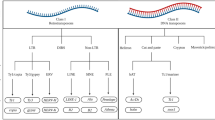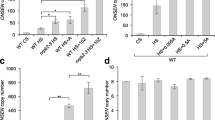Abstract
There is an inverse relationship between the level of cytosine methylation in genomic DNA and the activity of plant transposable elements. Increased transpositional activity is seen during early plant development when genomic methylation patterns are first erased and then reset. Prolonging the period of hypomethylation might therefore result in an increased transposition frequency, which would be useful for rapid genome saturation in transposon-tagged plant lines. We tested this hypothesis using transgenic rice plants containing Activator (Ac) from maize. R1 seeds from an Ac-tagged transgenic rice line were either directly germinated and grown to maturity, or induced to dedifferentiate in vitro, resulting in cell lines that were subsequently regenerated into multiple mature plants. Both populations were then analyzed for the presence, active reinsertion and amplification of Ac. Plants from each population showed excision-reinsertion events to both linked and unlinked sites. However, the frequency of transposition in plants regenerated from cell lines was more than nine-fold greater than that observed in plants germinated directly from seeds. Other aspects of transposon behavior were also markedly affected. For example, we observed a significantly larger proportion of transposition events to unlinked sites in cell line-derived plants. The tendency for Ac to insert into transcribed DNA was not affected by dedifferentiation. The differences in Ac activity coincided with a pronounced reduction in the level of genomic cytosine methylation in dedifferentiated cell cultures. We used the differential transposon behavior induced by dedifferentiation in the cell-line derived population for direct applications in functional genomics and validated the approach by recovering Ac insertions in a number of genes. Our results demonstrate that obtaining multiple Ac insertions is useful for functional annotation of the rice genome.
Similar content being viewed by others
References
Bancroft I. and Dean C. 1993. Transposition pattern of the maize element Ds in Arabidopsis thaliana. Genetics 134: 1221–1229.
Bhatt A.M., Lister C., Crawford N. and Dean C. 1998. The transposition frequency of Tag1 elements is increased in transgenic Arabidopsis lines. Plant Cell 10: 427–434.
Brettell R.I.S. and Dennis E.S. 1991. Reactivation of a silent Ac following tissue-culture is associated with heritable alterations in its methylation pattern. Mol. Gen. Genet. 229: 365–372.
Chin H.G., Choe M.S., Lee S.H., Park S.H., Park S.H., Koo J.C. et al. 1999. Molecular analysis of rice plants harboring an Ac/Ds transposable element-mediated gene trapping system. Plant J. 19: 615–623.
Courtial B., Feuerbach F., Eberhard S., Rohmer L., Chiapello H., Camilleri C. and Lucas H. 2001. Tnt1 transposition events are induced by in vitro transformation of Arabidopsis thaliana and transposed copies integrate into genes. Mol. Genet. Genom. 265: 32–42.
DeGreef B. and Jacobs M. 1996. Evidence for Tam3 activity in transgenic Arabidopsis thaliana. In Vitro Cell Dev. Biol. Plant 32: 241–248.
Dooner H.K., Belachew A., Burgess D., Hardings S., Ralston M. and Ralstone E. 1994. Distribution of unlinked receptor-sites for transposed Ac elements from the bz-m2(Ac) allele in maize. Genetics 136: 261–279.
Earp D.J., Lowe B. and Baker B. 1990. Amplification of genomic sequences flanking transposable elements in host and heterologous plants – a tool for transposon tagging and genome characterization. Nucleic Acids Res. 18: 3271–3279.
Edwards K., Johnstone C. and Thompson C. 1991. A simple and rapid method for the preparation of plant genomic DNA for PCR analysis. Nucleic Acids Res. 19: 1349–1349.
Enoki H., Izawa T., Kawahara M., Komatsu M., Koh S., Kyozuka J. and Shimamoto K. 1999. Ac as a tool for the functional genomics of rice. Plant J. 19: 605–613.
Goff S.A., Ricke D., Lan T.-H., Presting G., Wang R., Dunn M. et al. 2002. A draft sequence of the rice genome (Oryza sativa L. ssp. Japonica). Science 296: 92–100.
Grappin P., Audeon C., Chupeau M.C. and Grandbastien M.A. 1996. Molecular and functional characterization of Slide, an Ac-like autonomous transposable element from tobacco. Mol. Gen. Genet. 252: 386–397.
Greco R., Ouwerkerk P.B.F., Sallaud C., Kohli A., Columbo L., Puigdomenech P. et al. 2001a. Transposon insertional mutagenesis in rice. Plant Physiol. 125: 1175–1177.
Greco R., Ouwerkerk P.B.F., Taal A.J.C., Favalli C., Beguiristain T., Puigdomenech P. et al. 2001b. Early and multiple Ac transpositions in rice suitable for efficient insertional mutagenesis. Plant Mol. Biol. 46: 215–227.
Hamer L., DeZwaan T.M., Montenegro-Chamorro M.V., Frank S.A. and Hamer J.E. 2001. Recent advances in large-scale transposon mutagenesis. Curr. Opin. Chem. Biol. 5: 67–73.
Hirochika H., Sugimoto K., Otsuki Y., Tsugawa H. and Kanda M. 1996. Retrotransposons of rice involved in mutations induced by tissue culture. Proc. Natl. Acad. Sci. USA 93: 7783–7788.
Hirochika H. 1997. Retrotransposons of rice: their regulation and use for genome analysis. Plant Mol. Biol. 35: 231–240.
Hirochika H. 2001. Contribution of the Tos17 retrotransposon to rice functional genomics. Curr. Opin. Plant Biol. 4: 118–122.
Izawa T., Ohnishi T., Nakano T., Ishida N., Enoki H., Hashimoto H. et al. 1997. Transposon tagging in rice. Plant Mol. Biol. 35: 219–229.
Jaligot E., Rival A., Beule T., Dussert S. and Verdeil J. 2000. Somaclonal variation in oil palm (Elaeis guineensis Jacq.): the DNA methylation hypothesis. Plant Cell Rep. 19: 684–690.
Jeon J.S., Lee S., Jung K.H., Jun S.H., Jeong D.H., Lee J. et al. 2000. T-DNA insertional mutagenesis for functional genomics in rice. Plant J. 22: 561–570.
Jeon J.S. and An G.H. 2001. Gene tagging in rice: a high through-put system for functional genomics. Plant Sci. 161: 211–219.
Jones J.D.G., Carland F.C., Lim E., Raltson E. and Dooner H.K. 1990. Preferential transposition of the maize element Activator to linked chromosomal locations in tobacco. Plant Cell 2: 701–707.
Kaeppler S.M. and Phillips R.L. 1993. DNA methylation and tissue culture-induced variation. In Vitro Cell Dev. Biol. Plant 29: 125–130.
Kitamura K., Hashida S., Mikami T. and Kishima Y. 2001. Position effect of the excision frequency of the Antirrhinum transposon Tam3: implications for the degree of position-dependent methylation in the ends of the element. Plant Mol. Biol. 47: 475–490.
Kohli A., Xiong J., Greco R., Christou P. and Pereira A. 2001. Tagged transcriptome display (TTD) in indica rice using Ac transposition. Mol. Genet. Genom. 266: 1–11.
Koprek T., McElroy D., Louwerse J., Williams-Carrier R. and Lemaux P.G. 2000. An efficient method for dispersing Ds elements in the barley genome as a tool for determining gene function. Plant J. 24: 253–263.
Koprek T., Rangel S., McElroy D., Louwerse J.D., Williams-Carrier R.E. and Lemaux P.G. 2001. Transposon-mediated single-copy gene delivery leads to increased transgene expression stability in barley. Plant Physiol. 125: 1354–1362.
Koukalova B., Kuhrova V., Vyskot B., Siroky J. and Bezdek M. 1994. Maintenance of the induced hypomethylated state of tobacco nuclear repetitive DNA sequences in the course of protoplast and plant regeneration. Planta 194: 306–310.
Liu Y.G., Mitsukawa N., Oosumi T. and Whittier R.F. 1995. Efficient isolation and mapping of Arabidopsis thaliana T-DNA insert junctions by thermal asymmetric interlaced PCR. Plant J. 8: 457–463.
Maes T., De Keukelerie P. and Gerats T. 1999. Plant tagnology. Trends Plant Sci. 4: 90–96.
Mckenzie N., Wen L.Y. and Dale P.J. 2002. Tissue-culture enhanced transposition of the maize transposable element Dissociation in Brassica oleracea var. ‘Italica’. Theor. Appl. Genet. 105: 23–33.
Miura A., Yonebayashi S., Watanabe K., Toyama T., Shimada H. and Kakutani T. 2001. Mobilization of transposons by a mutation abolishing full DNA methylation in Arabidopsis. Nature 411: 212–214.
Morris P.C., Jessop A. and Altmann T. 1993. Selection for enhanced germinal excision of Ac in transgenic Arabidopsis thaliana. Theor. Appl. Genet. 86: 919–926.
Muller E., Brown P.T.H., Hartke S. and Lorz H. 1990. DNA variation in tissue-culture-derived rice plants. Theor. Appl. Genet 80: 673–679.
Nakagawa Y., Machida C., Machida Y. and Toriyama K. 2000. Frequency and pattern of transposition of the maize transposable element Ds in transgenic rice plants. Plant Cell Physiol. 41: 733–742.
Ozeki Y., Davies E. and Takeda J. 1997. Somatic variation during long term subculturing of plant cells caused by insertion of a transposable element in a phenylalanine ammonia-lyase (PAL) gene. Mol. Gen. Genet. 254: 407–416.
Parinov S. and Sundaresan V. 2000. Functional genomics in Arabidopsis: large-scale insertional mutagenesis complements the genome sequencing project. Curr. Opin. Biotechnol. 11: 157–161.
Peschke V.M. and Phillips R.L. 1991. Activation of the maize transposable element Suppressor-mutator (Spm) in tissue culture. Theor. Appl. Genet. 81: 90–97.
Peschke V.M., Phillips R.L. and Gengenbach B.G. 1987. Discovery of transposable element activity among progeny of tissue culture-derived maize plants. Science 238: 804–807.
Peschke V.M., Phillips R.L. and Gengenbach B.G. 1991. Genetic and molecular analysis of tissue culture-derived Ac elements. Theor. Appl. Genet. 82: 121–129.
Primrose S.B. and Twyman R.M. 2002. Principles of Genome Analysis and Genomics (3rd edn.) Blackwell Science, Oxford UK.
Richards E.J. 1997. DNA methylation and plant development. Trends Genet. 13: 319–323.
Ros F. and Kunze R. 2001. Regulation of Activator/Dissociation transposition by replication and DNA methylation. Genetics 157: 1723–1733.
Schmitt F., Oakeley E.J. and Jost J.P. 1997. Antibiotics induce genome-wide hypermethylation in cultured Nicotiana tabacum plants. J. Biol. Chem. 272: 1534–1540.
Seki M., Ito T., Shibata D. and Shinozaki K. 1999. Regional mutagenesis of specific genes on the CIC5F11/CIC2B9 locus of Arabidopsis thaliana chromosome 5 using the Ac/Ds transposon in combination with the cDNA scanning method. Plant Cell Physiol. 40: 624–639.
Smulders M., Rus-Kortekaas W. and Vosman B. 1995. Tissue culture-induced methylation polymorphisms in repetitive DNA of tomato calli and regenerated plants. Theor. Appl. Genet. 91: 1257–1264.
Sudhakar D., Duc L.T., Bong B.B., Tinjuangjun P., Maqbool S.B., Valdez M. et al. 1998. An efficient rice transformation system utilizing mature seed-derived explants and a portable, inexpensive particle bombardment device. Transgenic Res. 7: 289–294.
Sundaresan V., Springer P., Volpe T., Haward S., Jones J.D.G., Dean C. et al. 1995. Patterns of gene-action in plant development revealed by enhancer trap and gene trap transposable elements. Genes & Dev. 9: 1797–1810.
Takeda S., Sugimoto K., Otsuki H. and Hirochika H. 1999. A 13-bp cis-regulatory element in the LTR promoter of the tobacco retrotransposon Tto1 is involved in responsiveness to tissue-culture, wounding, methyl jasmonate and fungal elicitors. Plant J. 18: 383–393.
Vain P., Worland B., Kohli A., Snape J.W. and Christou P. 1998. Green fluorescent protein (GFP) as a vital screenable marker in rice transformation. Theor. Appl. Genet. 96: 164–169.
Walbot V. 2000. Saturation mutagenesis using maize transposons. Curr. Opin. Plant Biol. 3: 103–107.
Yoder J.A., Walsh C.P. and Bestor T.H. 1997. Cytosine methylation and the ecology of intragenomic parasites. Trends Genet. 13: 335–340.
Yu J., Hu S., Wang J., Wong G. K.-S., Li S., Liu B. et al. 2002. A draft sequence of the rice genome (Oryza sativa L. ssp. Indica). Science 296: 79–92.
Author information
Authors and Affiliations
Corresponding author
Additional information
These authors contributed equally to the work
Rights and permissions
About this article
Cite this article
Kohli, A., Prynne, M.Q., Miro, B. et al. Dedifferentiation-mediated changes in transposition behavior make the Activator transposon an ideal tool for functional genomics in rice. Molecular Breeding 13, 177–191 (2004). https://doi.org/10.1023/B:MOLB.0000018768.36290.94
Issue Date:
DOI: https://doi.org/10.1023/B:MOLB.0000018768.36290.94




